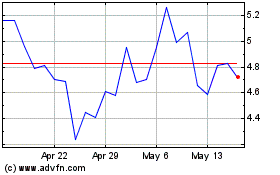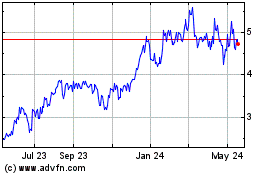Mean Change From Baseline in Disease Severity
Score (DSS) Showed Significant Improvement with Molgramostim
Compared with Placebo at Weeks 24 and 48
Responder Analysis Results for Percent
Predicted Diffusing Capacity of the Lungs for Carbon Monoxide
(DLCO%) Showed Significantly Higher Proportions of Molgramostim
Responders Compared with Placebo at Weeks 24 and 48
Responder Analysis Results for St. George’s
Respiratory Questionnaire (SGRQ) Total Score Supported Numeric and
Significant Improvements with Molgramostim Compared with Placebo at
Weeks 24 and 48, Respectively
Ground Glass Opacification (GGO) Score, a
Measure of Surfactant Burden, Significantly Improved with
Molgramostim Compared with Placebo at Week 24
Savara Inc. (Nasdaq: SVRA) (the Company), a clinical stage
biopharmaceutical company focused on rare respiratory diseases,
today announced that new data from the Phase 3 IMPALA-2 clinical
trial of molgramostim in patients with autoimmune Pulmonary
Alveolar Proteinosis (aPAP) were presented at the European
Respiratory Society (ERS) Congress 2024 in Vienna, Austria. The
poster from this presentation can be found here.
As previously announced, the IMPALA-2 trial met its primary
endpoint, achieving statistical significance in change from
baseline in hemoglobin-adjusted percent predicted diffusing
capacity of the lungs for carbon monoxide (DLCO%) at Week 24. This
statistically significant treatment difference was sustained
through Week 48, a secondary endpoint, which demonstrated
durability of effect. The treatment difference between molgramostim
and placebo for mean change from baseline to Week 24 in SGRQ Total
Score, a secondary endpoint, achieved statistical significance. Two
additional secondary endpoints reached nominal significance: SGRQ
Activity Score at Week 24 and exercise capacity using a treadmill
test at Week 48. Molgramostim was well tolerated and demonstrated a
favorable benefit/risk profile in the IMPALA-2 trial. In addition,
97% of patients completed the 48-week double-blind treatment
period, with only 2 patients discontinuing molgramostim due to
adverse events which were assessed by the investigator as not
related to study treatment. One hundred percent of the patients who
completed the double-blind period elected to participate in the
96-week open-label period.
New disease severity, responder analyses, and other results
measuring surfactant burden presented today at ERS, and summarized
below, further support the beneficial effects of molgramostim
compared with placebo.
Disease Severity Score (DSS)
The mean change from baseline in disease severity score, which
reflects symptoms and arterial partial pressure of oxygen, was
significantly more improved at Weeks 24 and 48 with molgramostim
compared with placebo.
DLCO% Responder Analysis
Results from a DLCO% responder analysis demonstrated
significantly higher proportions of responders with molgramostim
compared with placebo at Weeks 24 and 48. Odds ratios were
determined for patients achieving ≥ 5, 7, and 10 percentage point
improvements in DLCO% from baseline.
St. George’s Respiratory Questionnaire (SGRQ) Total Score
Responder Analysis
Results from an SGRQ Total Score responder analysis showed that
numerically (at Week 24) and significantly (at Week 48) higher
proportions of patients achieved each responder threshold of ≥ 4-,
8-, and 12-point improvements with molgramostim compared to
placebo.
Ground Glass Opacification (GGO) Score Results
GGO score, a radiological measure of surfactant burden, was
significantly improved with molgramostim compared with placebo at
Week 24.
“The IMPALA-2 results demonstrate molgramostim’s ability to
correct the pathobiology causing aPAP lung disease and improve its
cardinal manifestations,” said Bruce Trapnell, M.D., Professor of
Medicine and Pediatrics at the University of Cincinnati College of
Medicine and the Lead Clinical Investigator of the IMPALA-2 trial.
“Specifically, molgramostim reduced surfactant burden, increased
pulmonary gas transfer, improved health-related quality of life,
increased exercise capacity, and was well-tolerated in patients
with aPAP.”
Savara plans to complete submission of the Biologics License
Application (BLA) for molgramostim in aPAP in the first half of
2025. Molgramostim has been granted Orphan Drug, Fast Track, and
Breakthrough Therapy designations from the U.S. Food and Drug
Administration, Orphan Drug designation from the European Medicines
Agency and Innovative Passport and Promising Innovative Medicine
designation from the UK's Medicines and Healthcare Products
Regulatory Agency for the treatment of aPAP.
About the IMPALA-2 Trial
IMPALA-2 is a global, pivotal, Phase 3, 48-week, randomized,
double-blind, placebo-controlled clinical trial designed to compare
the efficacy and safety of molgramostim 300 mcg self-administered
once daily by inhalation with matching placebo in patients with
aPAP. The trial is being conducted at 43 clinical trial sites
across 16 countries, including the U.S., Canada, Japan, South
Korea, Australia, and countries in Europe, including Turkey. The
primary efficacy assessment is diffusing capacity of the lungs for
carbon monoxide (DLCO), a gas exchange measure, and the primary
endpoint is change from baseline to Week 24 in percent predicted
DLCO, with a secondary endpoint of change from baseline to Week 48
in percent predicted DLCO. Three additional secondary efficacy
variables evaluate clinical measures of direct patient benefit: St.
George’s Respiratory Questionnaire (SGRQ) Total Score, SGRQ
Activity Score, and exercise capacity using a treadmill test, with
each endpoint measured at Weeks 24 and 48. The primary time point
for efficacy assessments is at Week 24; however, efficacy was
assessed through Week 48 to evaluate durability of effect. Safety
was assessed through Week 48. All patients who completed the
48-week double-blind treatment period continued into a 96-week
open-label period during which they are receiving molgramostim 300
mcg administered once daily.
About aPAP
Autoimmune PAP is a rare lung disease characterized by the
abnormal build-up of surfactant in the alveoli (or air sacs) of the
lungs. Surfactant consists of proteins and lipids and is an
important physiological substance that lines the alveoli to prevent
them from collapsing. In a healthy lung, excess surfactant is
cleared and digested by immune cells called alveolar macrophages.
Alveolar macrophages need to be stimulated by
granulocyte-macrophage colony-stimulating factor (GM-CSF) to
function properly in clearing surfactant, but in autoimmune PAP,
GM-CSF is neutralized by antibodies against GM-CSF, rendering the
macrophages unable to adequately clear surfactant. As a result, an
excess of surfactant accumulates in the alveoli, causing impaired
gas exchange, resulting in clinical symptoms of shortness of
breath, often with cough and frequent fatigue. Patients may also
experience episodes of fever, chest pain, or coughing up blood,
especially if secondary lung infection develops. In the long-term,
the disease can lead to serious complications, including lung
fibrosis and the need for a lung transplant.
About Savara
Savara is a clinical stage biopharmaceutical company focused on
rare respiratory diseases. Our lead program, molgramostim nebulizer
solution, is an inhaled granulocyte-macrophage colony-stimulating
factor (GM-CSF) in Phase 3 development for autoimmune pulmonary
alveolar proteinosis (aPAP). Molgramostim is delivered via an
investigational eFlow® Nebulizer System (PARI Pharma GmbH)
specifically developed for inhalation of a large molecule. Our
management team has significant experience in rare respiratory
diseases and pulmonary medicine, identifying unmet needs, and
effectively advancing product candidates to approval and
commercialization. More information can be found at
www.savarapharma.com. (X, formerly known as Twitter: @SavaraPharma,
LinkedIn: www.linkedin.com/company/savara-pharmaceuticals/).
Forward-Looking Statements
Savara cautions you that statements in this press release that
are not a description of historical fact are forward-looking
statements within the meaning of the Private Securities Litigation
Reform Act of 1995. Forward-looking statements may be identified by
the use of words referencing future events or circumstances such as
“expect,” “intend,” “plan,” “anticipate,” “believe,” and “will,”
among others and include, but are not limited to, the anticipated
timing of our BLA submission. Savara may not actually achieve any
of the matters referred to in such forward-looking statements, and
you should not place undue reliance on these forward-looking
statements. These forward-looking statements are based upon
Savara’s current expectations and involve assumptions that may
never materialize or may prove to be incorrect. Actual results and
the timing of events could differ materially from those anticipated
in such forward-looking statements as a result of various risks and
uncertainties, which include, without limitation, the risks
associated with our ability to successfully develop, obtain
regulatory approval for, and commercialize molgramostim for aPAP;
the risks and uncertainties related to the impact of widespread
health concerns or changing economic or geopolitical conditions;
the ability to project future cash utilization and reserves needed
for contingent future liabilities and business operations; the
availability of sufficient resources for Savara’s operations and to
conduct or continue planned clinical development programs; and the
timing and ability of Savara to raise additional capital as needed
to fund continued operations. All forward-looking statements are
expressly qualified in their entirety by these cautionary
statements. For a detailed description of our risks and
uncertainties, you are encouraged to review our documents filed
with the SEC including our recent filings on Form 8-K, Form 10-K
and Form 10-Q. You are cautioned not to place undue reliance on
forward-looking statements, which speak only as of the date on
which they were made. Savara undertakes no obligation to update
such statements to reflect events that occur or circumstances that
exist after the date on which they were made, except as may be
required by law.
View source
version on businesswire.com: https://www.businesswire.com/news/home/20240908416244/en/
Savara Inc. IR & PR Anne Erickson
(anne.erickson@savarapharma.com) (512) 851-1366
Savara (NASDAQ:SVRA)
Historical Stock Chart
From Dec 2024 to Jan 2025

Savara (NASDAQ:SVRA)
Historical Stock Chart
From Jan 2024 to Jan 2025
